Gaming continues to evolve at a blistering pace, with innovations aiming to enhance player immersion beyond traditional visuals and audio. Enter the Razer Freya, a unique haptic gaming cushion that promises to shake up the gaming landscape as it delivers vibrations synchronously with in-game actions. This article takes a critical look at what the Freya has to offer, examining its functionality, compatibility, and overall value proposition to gamers.
Haptic technology has been gaining traction over the last several years. Its essence lies in replicating the sensation of touch, often through vibrations or movements. However, the Razer Freya introduces these principles to a new arena: the gaming cushion. Unlike traditional haptic devices like vests or chairs, this cushion aims to provide a direct interface between the game and gamers’ physical experiences. It is designed to be placed on a gaming chair and connects seamlessly to the Razer Synapse app, allowing users to customize their settings.
One of the key features is its six padded regions, each equipped with its own motor. These pads deliver distinct vibrations corresponding to various in-game events, aiming to enhance immersion. Whether it’s the rumble of an explosion or the subtle vibrations of footsteps, the cushion is designed to react in real-time, thus creating a multi-sensory gaming environment.
I had the opportunity to test the Freya ahead of its announcement at Razercon. The setup was straightforward: I strapped the cushion onto a Razer gaming chair and adjusted the settings on the Razer Synapse app. I dove into Final Fantasy XVI, a title built with haptic feedback support in mind. As I immersed myself in gameplay—casting spells and battling enemies—the feedback received from the cushion did create a nuanced sensation. The vibrations triggered by my character’s actions felt engaging, with pads responding dynamically depending on the gameplay.
However, while the initial experience was intriguing, it raised questions about sustained engagement. Over time, I found myself becoming desensitized to the varying vibrations. As someone who has participated in numerous gaming-deep experiences, I was left wondering whether the cushion could consistently enhance my gameplay over longer sessions.
The Freya is marketed primarily toward gamers, but its real value may lie in sim racing. Given my experiences with racing wheels and simulation setups, I can envision potential enhancements to the immersive experience of high-speed racing. Integrating the Freya into a sim racing setup could effectively close the gap between a standard racer and those extravagant full-motion rigs—without the hefty price tag.
Moreover, the cushion allows for the sensation of speed, impact, and vibration from various terrains, potentially elevating an average racing experience into something much more thrilling.
Yet, when considered beyond the racing genre, I found myself questioning the practical implications of long-term use. Would a horror game provide enough frightening vibrations to maintain interest? Would music modes offer anything beyond a novelty? My brief interaction left me curious but skeptical about its broader capabilities.
The Cost-Benefit Analysis
One cannot discuss the Razer Freya without considering its price tag, set at $300. While premium gaming devices often come with high costs, the value must be justified by unique and compelling experiences. After my encounter with the cushion, I remain ambivalent about whether the experience merits such an investment.
As a bass enthusiast, I also tested music compatibility. Listening to Chase & Status’s “Backbone” turned out to be a letdown. While the idea of a cushion vibrating to the rhythm of music is enticing, the execution failed to resonate personally.
Additionally, it feels cumbersome when considering that accessories like the new Razer Kraken V4 Pro headset—priced at $400—compete for attention as well.
Razer’s Freya undoubtedly has potential, bringing haptic technology into new realms of gaming experience. However, whether this product can secure a definitive place in a gamer’s toolkit remains to be determined. As captivating as the concept may be, the practicability and sustained enjoyment of the cushion is uncertain, leading to a lukewarm recommendation.
Those interested in creating an encompassing sim racing setup might find value here, but for casual players? I’d advise researching thoroughly before committing. As with most innovations, the true revolution lies in user adoption—will developers support this endeavor? Ultimately, the Freya stands as an intriguing exploration into the future of haptic gaming, but it might not be for everyone just yet.

